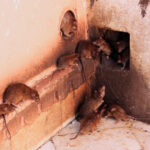How Can We Help?
Rats are notorious for their ability to infiltrate homes, and understanding the size of the holes they can enter is crucial for effective pest control. This blog post will explore how rats gain access to your home, the dimensions of the holes they can squeeze through, and what you can do to prevent infestations.
 Understanding Rat Entry Points
Understanding Rat Entry Points
Rats are remarkably agile and can fit through surprisingly small openings. Generally, they can squeeze through holes as small as 0.5 inches (about 12mm) in diameter. This means that if a hole is the width of a pencil, a rat can likely make its way through it. Their bodies are designed to collapse slightly, allowing them to navigate tight spaces that would seem impossible for such large rodents.
Common Hole Sizes
The size of the holes you might find around your home can vary, but typical rat burrows have openings that range from 2 to 4 inches in diameter. These holes often appear smooth and well-packed, with loose dirt scattered around the entrance, indicating recent use.
- Main burrow openings: 2 to 4 inches in diameter
- Minimum entry point: 0.5 inches in diameter
How Rats Create Entry Points
Rats possess strong teeth and a powerful jaw, enabling them to gnaw through various materials, including wood, plastic, and even concrete. This ability allows them to create their own entry points if they encounter barriers. They often exploit existing gaps around pipes, drains, and poorly sealed doors and windows.
Typical Locations for Rat Holes
Rats prefer to dig their burrows in areas that provide shelter and proximity to food sources. Common locations include:
- Near foundations: Holes can often be found around the base of your home, especially if there are cracks or gaps in the foundation.
- Under bushes or dense vegetation: These areas provide cover and are ideal for nesting.
- Along sidewalks and garden edges: Rats may create burrows in soft soil or areas with loose dirt.
 Identifying Rat Holes
Identifying Rat Holes
To determine if you have a rat problem, look for the following signs:
- Holes: Measure the diameter; if they are between 2 to 4 inches, they are likely from rats.
- Freshly excavated dirt: A fan-shaped pattern of loose dirt around the hole indicates recent activity.
- Gnaw marks: Look for evidence of chewing on wood, plastic, or other materials near the holes.
Preventing Rat Infestations
To keep rats out of your home, consider the following prevention strategies:
- Seal gaps: Check for and seal any holes larger than 0.5 inches around your home, especially near pipes and vents.
- Maintain cleanliness: Keep food stored securely and eliminate clutter that could provide shelter.
- Regular inspections: Periodically check for signs of rat activity, especially in areas where you have previously found holes.
- Professional pest control: If you suspect a rat infestation, hiring a pest control professional can help identify and eliminate the problem effectively.
By understanding the size and nature of the holes rats can enter, homeowners can take proactive measures to safeguard their properties from these persistent pests. Keeping your home sealed and clean will significantly reduce the chances of a rat invasion.


